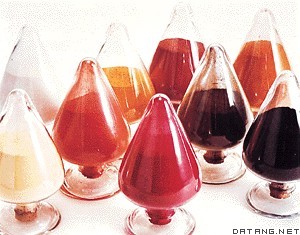1) dye-saturable absorber


染料饱和吸收器
2) saturable absorber


可饱和吸收器
3) Saturation absorption


饱和吸收
1.
Due to the saturation absorption characteristic of bacteriorhodopsin film, in holography, when the intensity of the recording light is higher than the saturation intensity, the distribution of the transmission of the holographic gratings deviates from the cosine shape.
由于菌紫质样品的饱和吸收特性,在全息记录中,当记录光强大于样品的饱和光强时,全息光栅透过率随记录光相位差的分布远离余弦型,因此衍射效率的稳定值很低。
4) saturable absorber


饱和吸收
1.
Fiber lasers using carbon nanotube as saturable absorber;


基于碳纳米管饱和吸收体的光纤激光器
2.
The laser is composite of a passively Q-switched laser with a saturable absorber placed in its cavity and a controlling LD with a focus system which is used to control the bleach degree of the absorber.
CPQL激光器由置于调Q激光器腔内的饱和吸收体和控制LD组成,控制LD用来控制饱和吸收体的漂白程度。
5) saturated absorption


饱和吸收
1.
Measurement and analysis of Rb-D_2 saturated absorption;


铷D_2线饱和吸收光谱的测量
2.
In this report,the modulatable saturated absorption of chemically enhanced bR film under multibeam illumination was studied.
本文首先研究了化学增强bR膜的互补调制饱和吸收,即多光束照射引起B、M各态粒子数比例变化,多光束之间互补调制输出光强。
3.
This kind of materials has obvious quantum confinement properties and large third-order nonlinear optical effects by studying their linear spectra and saturated absorption.
对线性吸收光谱和饱和吸收的研究表明该材料具有明显的量子限域特性和大的三阶非线性光学效应。
6) saturable absorption


饱和吸收
1.
5 kHz is presented, in which the self-written fiber grating induced by saturable absorption inner an unpumped Er3+ doped fiber at the standing-wave section is applied.
报道了利用在未泵浦掺铒光纤中,驻波饱和吸收诱发的自写入光纤光栅的窄带滤波特性及反射波长自适应特性,研制了单频光纤激光器,其线宽可窄至 0。
2.
Saturable absorption, reverse saturable absorption and re reverse saturable absorption under an Ar + laser beam in visible light range were observed.
报道了一种新型有机材料ZnTBP CA PhR的光学非线性吸收特性 ,此材料在激光作用下 ,在可见光区域具有反饱和吸收 ,再反饱和吸收和饱和吸收效应 。
3.
The saturable absorption (SA) and reverse saturable absorption (RSA) appeared as the input fluence increases and re-reverse resaturable absorption process of the material was d.
实验观察到此种材料显著的饱和及反饱和吸收现象 ,并观察到它的再反饱和过程 ,定性分析了变化过程中的物理机制。
补充资料:染料
| 染料 dye 能将纤维或其他被染物染成各种颜色的有机化合物。分天然染料和合成染料两大类。染色时先将染料制成水溶液、有机溶液、悬浮液等染液,当染液对纤维进行染色时,染料分子通过吸附、扩散以及一系列其他化学或物理化学的作用,从染液转移到纤维等被染物上,使其着色。 染料的颜色是染料对入射的可见光线发生选择吸收的结果。若入射的可见光线全部被物体吸收,则此物体呈黑色 ;若入射的可见光线全部被反射,则呈白色;若物体吸收入射的可见光线中某一段波长的光线,则此物体显示的颜色呈反射光线的颜色,吸收的光谱色和显示的颜色互为补色。当改变染料分子结构,使其最大吸收波长增大或缩短时,染料的色光就相应地加深或变浅。染料吸收可见光线的范围和颜色的纯度有关,吸收范围愈窄,颜色的纯度愈高。染料的吸收曲线形状各异,颜色也千差万别。染料分子中含有一个或数个特殊的官能团,称为发色团,如偶氮基、硝基、亚硝基 、羰基等。这些发色团在吸收光线后产生的电子跃迁不同,最大吸收波长也不同。此外,染料必须含有助色团,如氨基 、羟基、磺酸基和甲基等,它们对染料的色光、纯度、深浅度和溶解度等都有影响。 使被染物着色后,抵抗外界各类化学、物理机械等作用并保持原来色泽的能力,称为坚牢度或牢度。抵抗能力大的即牢度高,小的即牢度低。通常以标准试样作为牢度的基准,采用比较法来确定若干等级,如耐光牢度分为8级,耐洗、耐氯漂、耐摩擦、耐升华等牢度均分为5级,级数越小,牢度越低。牢度的高低,决定于染料和被染物的性质以及染色的方法。
染料主要用于各种纤维的染色,如棉、丝、毛、麻等天然纤维和粘胶、醋酯、涤纶、锦纶、腈纶等化学纤维。此外,也广泛应用于纸张、木材、皮革、涂料、塑料、油墨、墨水、感光材料、食品、医药、化妆品和指示剂等方面。近些年,液晶、压敏、增感等元件以及太阳能利用、激光等所用的功能性染料也得到开发和应用。 |
说明:补充资料仅用于学习参考,请勿用于其它任何用途。
参考词条
